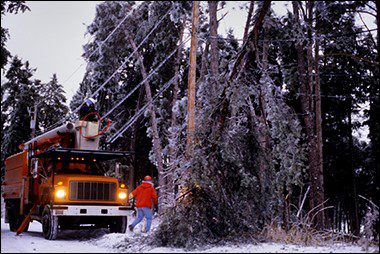
Outdoor work requires proper preparation, especially in severe winter weather conditions. Although OSHA does not have a specific standard that covers working in cold environments, employers have a responsibility to provide workers with employment and a place of employment which are free from recognized hazards, including winter weather related hazards, which are causing or are likely to cause death or serious physical harm to them (Section 5(a)(1) of the Occupational Safety and Health Act of 1970).
- Cold Stress:
- How to recognize the symptoms of cold stress, prevent cold stress injuries and illnesses
- The importance of self-monitoring and monitoring coworkers for symptoms
- First aid and how to call for additional medical assistance in an emergency
- How to select proper clothing for cold, wet, and windy conditions
- Other winter weather related hazards that workers may be exposed to, for example, slippery roads and surfaces, windy conditions, and downed power lines
- How to recognize these hazards
- How workers will be protected: engineering controls, safe work practices and proper selection of equipment, including personal protective equipment
Dressing Properly for the Cold
Dressing properly is extremely important to preventing cold stress. When cold environments or temperatures cannot be avoided, the following would help protect workers from cold stress:
- Wear at least three layers of loose fitting clothing. Layering provides better insulation.
- An inner layer of wool, silk or synthetic (polypropylene) to keep moisture away from the body. Thermal wear, wool, silk or polypropylene, inner layers of clothing that will hold more body heat than cotton.
- A middle layer of wool or synthetic to provide insulation even when wet.
- An outer wind and rain protection layer that allows some ventilation to prevent overheating.
- Tight clothing reduces blood circulation. Warm blood needs to be circulated to the extremities. Insulated coat/jacket (water resistant if necessary)
- Knit mask to cover face and mouth (if needed)
- Hat that will cover your ears as well. A hat will help keep your whole body warmer. Hats reduce the amount of body heat that escapes from your head.
- Insulated gloves (water resistant if necessary), to protect the hands
- Insulated and waterproof boots to protect the feet
Safety Tips for Workers
- Your employer should ensure that you know the symptoms of cold stress
- Monitor your physical condition and that of your coworkers
- Dress appropriately for the cold
- Stay dry in the cold because moisture or dampness, e.g. from sweating, can increase the rate of heat loss from the body
- Keep extra clothing (including underwear) handy in case you get wet and need to change
- Drink warm sweetened fluids (no alcohol)
- Use proper engineering controls, safe work practices, and personal protective equipment (PPE) provided by your employer
When you plan, equip, and train for cold weather conditions, you help ensure the protection of yourself and your crew members during the harshest of conditions.
Until next time…Work Safe, Be Safe!




